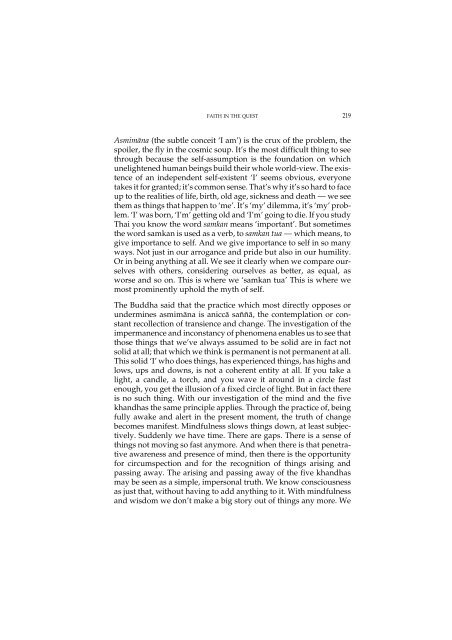Forest Path - Amaravati Buddhist Monastery
Forest Path - Amaravati Buddhist Monastery
Forest Path - Amaravati Buddhist Monastery
You also want an ePaper? Increase the reach of your titles
YUMPU automatically turns print PDFs into web optimized ePapers that Google loves.
faith in the quest 219<br />
Asmimàna (the subtle conceit ‘I am’) is the crux of the problem, the<br />
spoiler, the fly in the cosmic soup. It’s the most difficult thing to see<br />
through because the self-assumption is the foundation on which<br />
unelightened human beings build their whole world-view. The existence<br />
of an independent self-existent ‘I’ seems obvious, everyone<br />
takes it for granted; it’s common sense. That’s why it’s so hard to face<br />
up to the realities of life, birth, old age, sickness and death — we see<br />
them as things that happen to ‘me’. It’s ‘my’ dilemma, it’s ‘my’ problem.<br />
‘I’ was born, ‘I’m’ getting old and ‘I’m’ going to die. If you study<br />
Thai you know the word samkan means ‘important’. But sometimes<br />
the word samkan is used as a verb, to samkan tua — which means, to<br />
give importance to self. And we give importance to self in so many<br />
ways. Not just in our arrogance and pride but also in our humility.<br />
Or in being anything at all. We see it clearly when we compare ourselves<br />
with others, considering ourselves as better, as equal, as<br />
worse and so on. This is where we ‘samkan tua’ This is where we<br />
most prominently uphold the myth of self.<br />
The Buddha said that the practice which most directly opposes or<br />
undermines asmimàna is aniccà sa¤¤à, the contemplation or constant<br />
recollection of transience and change. The investigation of the<br />
impermanence and inconstancy of phenomena enables us to see that<br />
those things that we’ve always assumed to be solid are in fact not<br />
solid at all; that which we think is permanent is not permanent at all.<br />
This solid ‘I’ who does things, has experienced things, has highs and<br />
lows, ups and downs, is not a coherent entity at all. If you take a<br />
light, a candle, a torch, and you wave it around in a circle fast<br />
enough, you get the illusion of a fixed circle of light. But in fact there<br />
is no such thing. With our investigation of the mind and the five<br />
khandhas the same principle applies. Through the practice of, being<br />
fully awake and alert in the present moment, the truth of change<br />
becomes manifest. Mindfulness slows things down, at least subjectively.<br />
Suddenly we have time. There are gaps. There is a sense of<br />
things not moving so fast anymore. And when there is that penetrative<br />
awareness and presence of mind, then there is the opportunity<br />
for circumspection and for the recognition of things arising and<br />
passing away. The arising and passing away of the five khandhas<br />
may be seen as a simple, impersonal truth. We know consciousness<br />
as just that, without having to add anything to it. With mindfulness<br />
and wisdom we don’t make a big story out of things any more. We

















